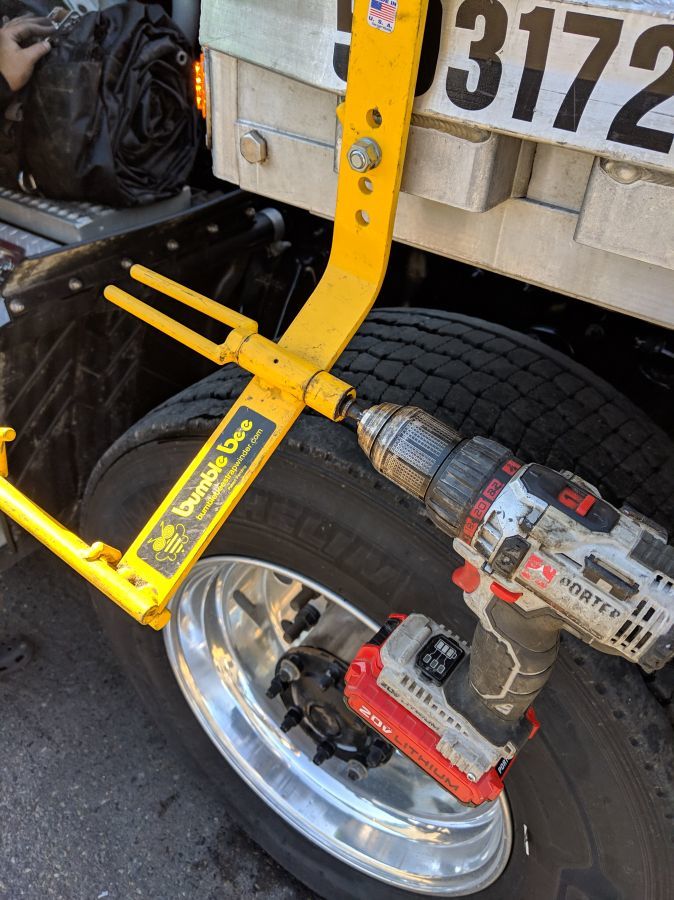Flatbed Speedy Securement, Unsecurement And Organization!
Topic 27716 | Page 1
Practice, practice and more practice. The speed will come but speed isn't important. What matters is getting the securement correct and accounting for potential situations which can cause things to go sideways in a hurry. Focus more on the basics and looking at each load, figuring out exactly what it needs. Don't worry about whether or not you're meeting the minimum requirements. Worry more about, my family is in the vehicle's next to me and are they safe with what I've done to secure my load.
With a wallboard load I take everything off and then try to clean up while they are unloading me. With a coil I try to have everything ready to go before I get in the door.
Try to get the tarps off and if possible, move them to the sides of the cab. Release the straps next and when you are on the passenger side of the trailer, gather those straps with the hook ends and toss them under the trailer just behind the drive wheels. Kick the excess straps under the trailer so a forklift doesn't run over anything. Gather the hook ends on the driver's side of the trailer and lay the hooks down against the drive tires and kick the excess under the trailer.
Now they can unload and your equipment is safe while you begin folding tarps. Once that is done, you can start rolling straps. Might I suggest a Bumblebee (pictured).
Any drill will work with a 3/8 Chuck bit.
If they try to hurry you off the lot, toss your tarps up on the flatbed and then your straps up there as well, drive around to where you aren't blocking yard traffic and finish up at your STEADY and SAFE speed.

I guess I should clarify, you are releasing the straps and pulling the strap off the load by pulling from the hook end, yes? If so, the first paragraph assumes you go down the driver's side trailer loosening those straps and then up the passenger side, pulling the loosened straps over and gathering the hooks etc.
How have you been going about it for the most part?
HOS:
Hours Of Service
HOS refers to the logbook hours of service regulations.OOS:
When a violation by either a driver or company is confirmed, an out-of-service order removes either the driver or the vehicle from the roadway until the violation is corrected.
Sorry, just noticed you haven't gotten a single response from a flatbed moderator yet as requested. I'm sure there will be a bunch soon or tomorrow tho
Victor, everyone has given you great advice. Being fast isn't what newbies need to focus on. Doing it right is far more beneficial. You're a flatbedder - you're responsible for making sure that load doesn't spill onto the roadways. Get it right!
Look, all the extra work we do takes time. Efficiency will come along as you get more proficient. Robert said...
Practice, practice and more practice. The speed will come but speed isn't important. What matters is getting the securement correct and accounting for potential situations which can cause things to go sideways in a hurry.
Excellent advice!
Rubber Duck said...
I take everything off and then try to clean up while they are unloading me.
Also excellent advice! There are plenty of locations where you can strip your tarps off, pull them to the side, and reposition your truck so they can be unloading you while you're rolling up your tarps.
Spaceman suggests procedural steps/processes and tools that help you go faster. A strap winder speeds up the rolling of the straps, and thinking about the whole process as he suggests helps you do more work with less steps. You don't have to buy a drill right now. A simple hand powered strap winder can be purchased at most truck stops.
Keep up the good work! Don't beat yourself up all the time. Be proud of your accomplishments and take the necessary steps to improve your results.
A lot of times I will untarp first to get to my straps and then unstrap my load and roll up my straps. When I am tarping or strapping a load it takes me a while cause I am getting on top of my load to untangle my straps or put edge protectors on it cause I dont have a pole for that; and tarping takes a while cause my strength is not quite up to par. Like its hard still to get my tarp up on the trailer after rolling it up and bungiing it. The coils took me forever to get tarped. I mean I had to get help to even them out and all.
Try to get the tarps off and if possible, move them to the sides of the cab. Release the straps next and when you are on the passenger side of the trailer, gather those straps with the hook ends and toss them under the trailer just behind the drive wheels. Kick the excess straps under the trailer so a forklift doesn't run over anything. Gather the hook ends on the driver's side of the trailer and lay the hooks down against the drive tires and kick the excess under the trailer.
Now they can unload and your equipment is safe while you begin folding tarps. Once that is done, you can start rolling straps. Might I suggest a Bumblebee (pictured).
Any drill will work with a 3/8 Chuck bit.
If they try to hurry you off the lot, toss your tarps up on the flatbed and then your straps up there as well, drive around to where you aren't blocking yard traffic and finish up at your STEADY and SAFE speed.
I guess I should clarify, you are releasing the straps and pulling the strap off the load by pulling from the hook end, yes? If so, the first paragraph assumes you go down the driver's side trailer loosening those straps and then up the passenger side, pulling the loosened straps over and gathering the hooks etc.
How have you been going about it for the most part?
HOS:
Hours Of Service
HOS refers to the logbook hours of service regulations.OOS:
When a violation by either a driver or company is confirmed, an out-of-service order removes either the driver or the vehicle from the roadway until the violation is corrected.
Thank you Old School, certainly will take that advice. Could I buy that Bumble Bee strap wrapper anywhere? I do have the hand held one and that helps a lot!
Victor, everyone has given you great advice. Being fast isn't what newbies need to focus on. Doing it right is far more beneficial. You're a flatbedder - you're responsible for making sure that load doesn't spill onto the roadways. Get it right!
Look, all the extra work we do takes time. Efficiency will come along as you get more proficient. Robert said...
Practice, practice and more practice. The speed will come but speed isn't important. What matters is getting the securement correct and accounting for potential situations which can cause things to go sideways in a hurry.
Excellent advice!
Rubber Duck said...
I take everything off and then try to clean up while they are unloading me.
Also excellent advice! There are plenty of locations where you can strip your tarps off, pull them to the side, and reposition your truck so they can be unloading you while you're rolling up your tarps.
Spaceman suggests procedural steps/processes and tools that help you go faster. A strap winder speeds up the rolling of the straps, and thinking about the whole process as he suggests helps you do more work with less steps. You don't have to buy a drill right now. A simple hand powered strap winder can be purchased at most truck stops.
Keep up the good work! Don't beat yourself up all the time. Be proud of your accomplishments and take the necessary steps to improve your results.
It currently takes me about 2 hours to secure and tarp my loads. However I make sure everything is right and tight the first time. I very seldom have to add bungee or tighten chains and straps.
My unsecure speed gets faster every time. If I'm unloading outside I try to position my truck to where they will unload from drivers side. That way I can pull tarps and straps to passenger side. I get tarps folded first. The straps I stretch out with loose ends toward the front of trailer it makes using my hand crank winder easier. If using chains I'll pile them up on front of the trailer so either while unloading or after I can stand on catwalk and put them up.
Sometimes you just have to pile everything on the trailer and pull around to reset it. I deliver in and around Chicago a lot. I have learned it is possible to fold a steel tarp on top of the trailer if you have to park on side of street. However there is no easy way to fold the lumber tarps without stretching them out, at least not that i have found so far. At the moment I'm 30 actual days out with 10000 plus miles so I'm still learning as well.
OOS:
When a violation by either a driver or company is confirmed, an out-of-service order removes either the driver or the vehicle from the roadway until the violation is corrected.
When I did flatbed I would take everything off minus a few straps or chains while i was waiting to be unloaded. Very seldom did i pull into a place and they were ready to unload me as soon as i pulled the ketchup and mustard. In those instances I did what everybody else is telling you. Get everything off and out of the way, and then clean up while being unloaded.
HOS:
Hours Of Service
HOS refers to the logbook hours of service regulations.New Reply:
New! Check out our help videos for a better understanding of our forum features

















Preview:








 TT On Facebook
TT On Facebook
So i have been having a really been having a terrible time trying to get my securement on quick and then off and out of the way quick. I took an hour and a half and some change, today at my reciever. I have encountered this problem many times. I can only think that there are others like me needing help in this area. Muscles are not everything so what is? Moderators and thosw who know, we thank you for your help!
HOS:
Hours Of Service
HOS refers to the logbook hours of service regulations.